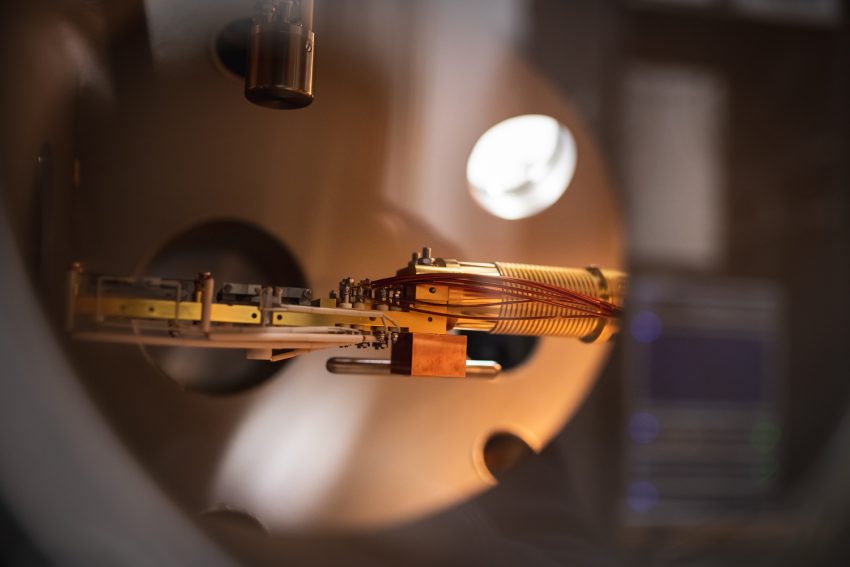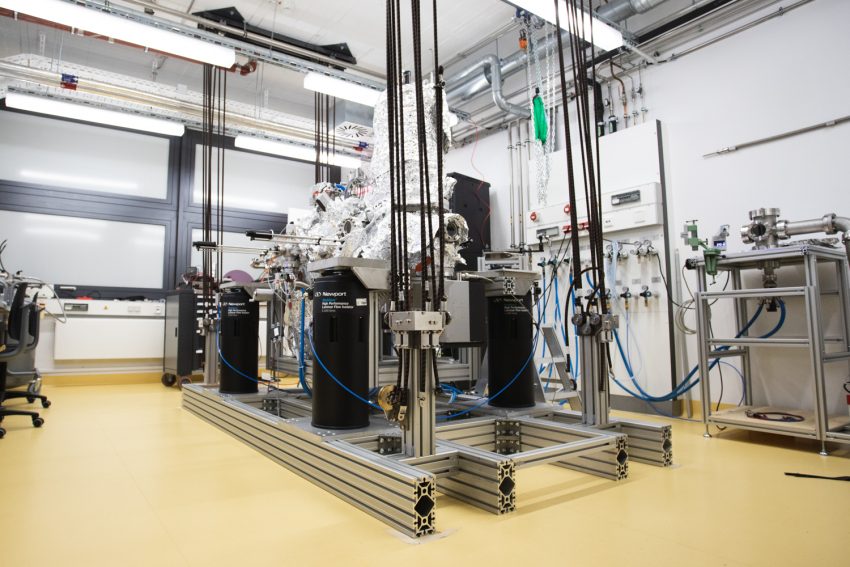Picture of the Month: A showroom for single atoms From the Institute of Applied Physics
Anyone currently entering laboratory 005 at the LENA research center is initially a little taken aback. A large stainless steel device hangs from the ceiling. The working group “Nanoscopic Systems” is still setting up its self-constructed so-called photon scanning tunneling microscope (P-STM). Nevertheless, we were allowed to look into the heart of the microscope for the “Picture of the Month”.

The main chamber of the Photon-STM. Easily recognizable: The tip holder above the sample. Picture credits: Max Fuhrmann/TU Braunschweig
You have to come up with something if you want to image individual atoms and molecules. The Photon-STM (Scanning Tunneling Microscope) brings a tip as close as possible to the sample surface. But without touching it. Only two to five atoms then fit between tip and sample. Despite multiple vibration damping, even the slightest vibration is enough to cause unwanted contact. For example, when someone walks through the room.
If everything goes as planned, the microscope collects its information via a low but extremely precise electrical signal. This involves moving the tip line by line across the surface of the sample. Changes in the current signal provide information on height differences and electronic properties for each point. This makes it possible to visualize even individual atoms on the surface.
Glowing molecules
In the “Picture of the Month”, you can see the holder for the tip, the sample and an extremely well-polished mirror. The end of the tip itself is so thin that it cannot be seen with the human eye. The fact that one can look into the microscope at all is what makes the Photon-STM so special. Later, an applied current will cause individual molecules to glow, which a special camera will then observe directly through the window. In the background is a high-precision mirror. Its purpose is to direct as much light as possible to the outside.

Before a sample is allowed into the main chamber of the Photon-STM, it has been prepared in a secondary chamber. Transport between the chambers is handled by the manipulator shown here. Picture credits: Max Fuhrmann/TU Braunschweig
In addition, the Photon STM has a high temporal resolution. It detects processes that take place in the range of a trillionth of a second. In this way, it detects at which points and at what speed electrical energy is converted into light in a molecule.
However, the device can not only make individual atoms visible, but also place them at specific locations with the help of the tip. Atom by atom, artificial molecules can thus be produced. With such basic research, Professor Uta Schlickum’s working group, as part of the Cluster of Excellence QuantumFrontiers, is for instance clearing the way for future dyes improving solar cells or OLEDS.
Data transmission for quantum computers

Laboratory 005 at LENA. With the support of the Cluster of Excellence QuantumFrontiers, the Photon-STM is being built here. Photo credit: Max Fuhrmann/TU Braunschweig.
The Photon STM can also light up and study so-called single photon sources, consisting of a single molecule. The special thing about such sources is already in the name: Two or more light particles (photons) are never created exactly at the same time. What would be a bit thin as a lamp, to say the least, is in great demand for quantum information transfer. In the near future, such light sources could secure data transmission between two quantum computers – such as those from Quantum Valley Lower Saxony.

